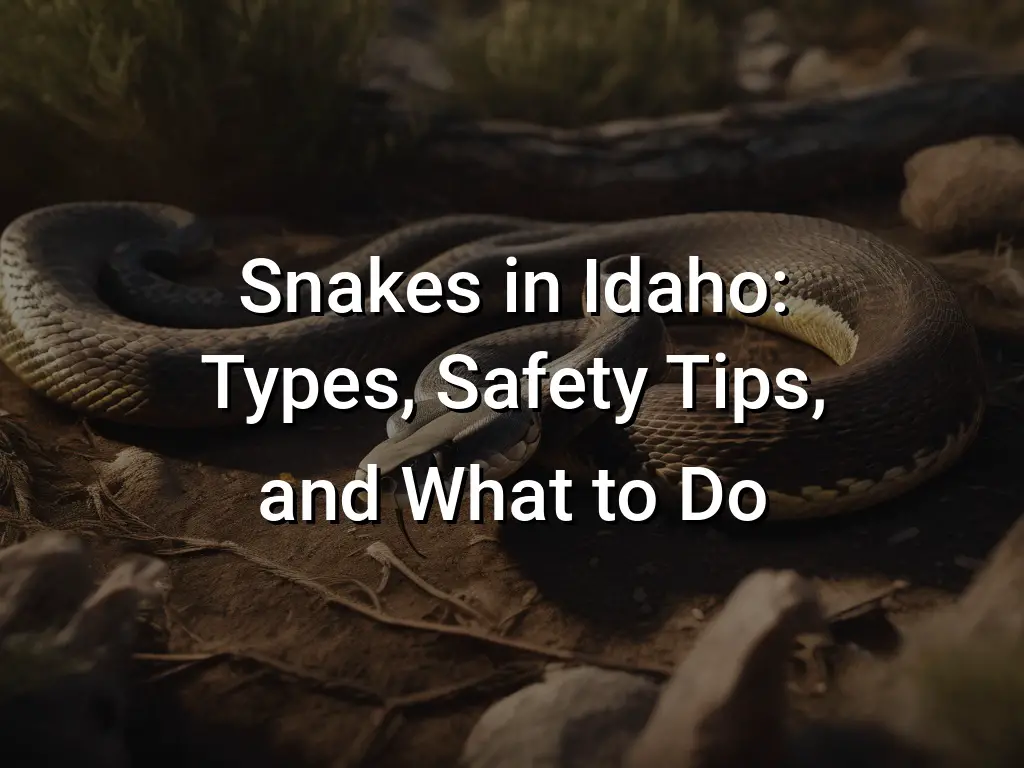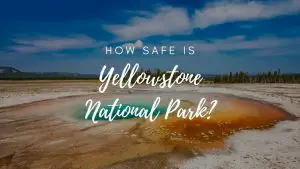Snakes in Idaho: Types, Safety Tips, and What to Do

Snakes in Idaho? You bet! Idaho may not be the first place that comes to mind when you think of snakes, but this diverse state is home to a variety of fascinating snakes. From venomous rattlesnakes to harmless garter snakes, Idaho offers plenty of opportunities for snake enthusiasts to explore.
In this article, we’ll introduce you to the different types of snakes found in Idaho, including rattlesnakes, garter snakes, bull snakes, and rubber boas. We’ll also share some safety tips for encountering snakes in the wild, as well as what to do if you find yourself bitten by a snake. So whether you’re a curious hiker or a passionate herpetologist, join us as we dive into the world of snakes in Idaho.
Quick Links
Types of Snakes
Idaho is home to a variety of snake species, each with its own unique characteristics and habits. Understanding the different types of snakes in the area can help you identify them and know how to safely coexist. Here are some of the most common snake species found in Idaho:
- Rattlesnakes: Rattlesnakes are venomous snakes known for the distinctive rattling sound they make with their tails. They have triangular-shaped heads and heat-sensing pits on their faces. Rattlesnakes are most active during the warmer months and can be found in different habitats, including grasslands, deserts, and forests.
- Garter Snakes: Garter snakes are non-venomous snakes found throughout Idaho. They have long, slender bodies with distinct stripes running down their backs. Garter snakes are active during the day and are commonly found near water sources, such as ponds, streams, and marshes.
- Bull Snakes: Bull snakes are large, non-venomous snakes that can grow up to 6 feet in length. They have a reputation for hissing loudly and mimicking the sound of a rattlesnake, but they are harmless to humans. Bull snakes can be found in grasslands, sagebrush steppe, and agricultural areas.
- Rubber Boas: Rubber boas are small, non-venomous snakes with a unique appearance. They have short tails and are covered in smooth, rubbery scales. Rubber boas are primarily found in forested areas, where they spend a lot of time burrowing in the soil and leaf litter.
It’s important to remember that not all snakes in Idaho are dangerous or harmful. Most snakes are beneficial to the ecosystem, as they help control rodent populations. However, it’s always best to give snakes their space and avoid disturbing them whenever possible.
Rattlesnakes in Idaho
Rattlesnakes are venomous snakes that can be found in various habitats across Idaho. There are three species of rattlesnakes that are native to the state: the Western rattlesnake, the Great Basin rattlesnake, and the Prairie rattlesnake. These snakes are known for their distinct rattles at the end of their tails, which they use as a warning sign when they feel threatened.
Rattlesnakes are typically found in rocky areas, grasslands, and shrublands, but they can also be encountered in forests and near water sources. They are ambush predators, meaning they lie in wait for their prey to come close before striking. Their diet primarily consists of small mammals, birds, and other reptiles. Rattlesnakes play an important role in the ecosystem by helping to control rodent populations.
If you come across a rattlesnake in Idaho, it’s important to remember that they are generally not aggressive towards humans and will usually try to avoid confrontation. However, it’s essential to exercise caution and follow these safety tips:
- Keep a safe distance: Stay at least six feet away from a rattlesnake if you encounter one.
- Do not provoke or handle a rattlesnake: Trying to capture or handle a rattlesnake can be extremely dangerous. Leave them alone and let them move away on their own.
- Watch your step: Be cautious when walking in snake habitat, especially in tall grass, rocky areas, and under logs or rocks.
- Wear appropriate footwear and clothing: When hiking or exploring snake-prone areas, wear closed-toe shoes, long pants, and tall socks to protect yourself from potential bites.
- Use a flashlight at night: Snakes are more active during the warmer months, so if you’re hiking or camping at night, use a flashlight to watch for snakes on the trail.
- Teach children about snake safety: Educate children about the dangers of snakes and how to safely respond if they encounter one.
In the event of a rattlesnake bite, it’s important to seek medical attention immediately. Do not attempt to treat the bite yourself, as snake venom can cause severe tissue damage and other complications. Call emergency services or go to the nearest hospital as soon as possible.
Remember, rattlesnakes are an important part of Idaho’s ecosystem, and they play a role in maintaining a balanced wildlife population. By following safety tips and respecting their habitat, you can coexist safely with these fascinating snakes.
Garter Snakes in Idaho
Garter snakes are one of the most common snake species found in Idaho. They are non-venomous snakes that can be identified by their slender bodies and distinctive stripes running along their length. Garter snakes are named for their habit of releasing a foul-smelling musk when threatened or handled.
In Idaho, there are three main species of garter snakes: the common garter snake (Thamnophis sirtalis), the wandering garter snake (Thamnophis elegans), and the terrestrial garter snake (Thamnophis elegans terrestris).
Common garter snakes are the most widespread and can be found in a variety of habitats, including grasslands, meadows, wetlands, and even suburban areas. They are known for their adaptability and can tolerate a wide range of temperatures and environments.
Wandering garter snakes are typically found near bodies of water, such as streams, ponds, and marshes. They are excellent swimmers and are often seen near the water hunting for food, which primarily consists of amphibians and small fish.
Terrestrial garter snakes, as their name suggests, are typically found in drier, more upland habitats, such as forests and open woodlands. They are skilled climbers, often seen basking in the sun on rocks or logs.
Garter snakes play an important role in the ecosystem as both predators and prey. They help control populations of small rodents, insects, and amphibians. Garter snakes are also an important food source for larger predators like birds of prey and mammals.
When encountering a garter snake in Idaho, it is important to remember that they are non-venomous and generally harmless to humans. However, it is advisable to give them space and avoid handling them, as they may bite or release musk if they feel threatened. If you have a garter snake in your yard or home and would like it removed, it is recommended to contact a professional wildlife removal service.
Overall, garter snakes are fascinating reptiles that contribute to the biodiversity of Idaho’s ecosystems. By respecting their natural habitats and observing them from a safe distance, we can appreciate their beauty and ecological importance.
Bull Snakes in Idaho
Bull snakes are a common species of snake found in Idaho. They are non-venomous and are often mistaken for rattlesnakes due to their similar appearance and behavior. However, bull snakes do not have a rattle on their tail and are harmless to humans.
These snakes are known for their large size, with some adults reaching lengths of up to 6 feet. They have a distinctive pattern of dark brown or black blotches on a lighter background, which helps to camouflage them in their surroundings.
Bull snakes are primarily found in grasslands, open forests, and agricultural areas throughout Idaho. They are active during the day and are excellent climbers, often found in trees or on fence posts.
These snakes are beneficial to the ecosystem as they help to control rodent populations by feeding on mice, rats, and other small mammals. They also eat birds, bird eggs, and occasionally other snakes.
If you encounter a bull snake in the wild, it is important to remember that they are not venomous and pose no threat to humans. It is best to keep a safe distance and observe them from afar. Do not attempt to handle or provoke the snake, as this could result in defensive behavior.
It is also important to note that bull snakes are a protected species in Idaho, and it is illegal to kill, harm, or remove them from their natural habitat without proper permits or licenses.
Overall, bull snakes play an important role in the ecosystem of Idaho and should be respected and appreciated for their contributions to the environment.
Rubber Boas in Idaho
Rubber Boas (Charina bottae) are a unique species of snake found in Idaho. They are the smallest and most docile of the four snake species found in the state. Rubber Boas have a distinct appearance with their smooth, rubbery skin and short, stubby tail. They are typically brown in color, but can also be tan or olive. Some individuals may have darker patches or stripes on their bodies.
These snakes have a slow-moving and gentle temperament, making them a favorite among snake enthusiasts. They are known for their habit of curling up and hiding their heads within the coils of their body when they feel threatened. This defensive behavior, along with their small size, makes them less likely to bite or pose a danger to humans.
Rubber Boas are primarily nocturnal, preferring to hunt and explore at night. They are excellent climbers and are often found in forested areas, rocky slopes, or grasslands. These snakes are adept at burrowing and are commonly found under rocks, logs, or in rodent burrows.
In terms of diet, Rubber Boas primarily feed on small mammals, such as mice, voles, and shrews. They are constrictors, meaning they wrap their bodies around their prey and suffocate them before swallowing whole. They have a slow metabolism, so they can go for extended periods without eating.
Rubber Boas are not a common snake to encounter in Idaho due to their elusive nature and nocturnal habits. However, if you do come across a Rubber Boa, it is important to remember to observe them from a distance and not disturb their natural habitat. These snakes play a vital role in the ecosystem as predators of small mammals, helping to maintain a balanced population of these prey species.
If you are fortunate enough to observe a Rubber Boa in the wild, appreciate this unique and fascinating snake from a safe distance and be sure to leave it undisturbed.
Safety Tips for Encountering Snakes
Encountering snakes can be a nerve-wracking experience, but with the right precautions, you can reduce the risk of a negative encounter. Here are some safety tips to keep in mind:
- Stay calm: If you come across a snake, try to remain calm and avoid sudden movements. Snakes typically want to avoid humans and will only bite if they feel threatened.
- Keep your distance: Always maintain a safe distance from a snake. Do not try to handle or provoke it in any way. Use binoculars or a zoom camera lens to observe it from a safe distance.
- Wear suitable clothing: When exploring snake-prone areas, consider wearing long pants, sturdy boots, and thick socks. This can provide a barrier between your skin and any potential snake bites.
- Watch where you step: Be cautious when hiking or walking in tall grass, rocky areas, or near water sources. Snakes can be camouflaged and may be difficult to spot.
- Stick to designated trails: Stick to well-defined paths and avoid venturing into overgrown or unexplored areas where snakes may be hiding.
- Use a walking stick: Carrying a walking stick can help alert snakes to your presence and give you a chance to react accordingly. It can also be used to gently prod the ground in front of you to check for hidden snakes.
- Stay aware of your surroundings: Stay alert and keep an eye out for signs of snake activity, such as rustling in leaves or a distinctive hissing sound.
- Don’t approach or disturb snakes: Do not try to touch or handle a snake, even if it appears harmless. Some snakes can deliver venomous bites, and it’s not always easy to identify the species at a glance.
- Teach children about snake safety: Educate children about snake safety and encourage them to follow these guidelines as well. Teach them to stay away from snakes and to inform an adult if they spot one.
- Know the emergency contact numbers: In case of a snakebite or emergency, be familiar with the local emergency numbers and the nearest medical facilities.
By following these safety tips, you can minimize the risk of snake encounters and ensure a safe and enjoyable outdoor experience in snake-prone areas.
What to Do if Bitten by a Snake
If you are bitten by a snake, it is important to stay calm and take immediate action. Here are some steps to follow:
- Remove yourself from the snake’s vicinity to avoid further bites or injuries.
- Try to identify the snake, if possible, but do not waste time or put yourself at risk to do so.
- Keep the bitten area below heart level to slow the spread of venom.
- Remove any tight clothing or jewelry near the bite site, as it may constrict blood flow if swelling occurs.
- Clean the wound gently with soap and water, if available, to reduce the risk of infection.
- Apply a clean, sterile bandage or cloth to the wound to control bleeding.
- Seek medical attention immediately. Call emergency services or go to the nearest hospital.
- Do not try to suck out venom or use a tourniquet, as these methods are ineffective and may cause more harm.
- Keep calm and still to slow the spread of venom through your system. Avoid unnecessary movement.
- Provide information to medical professionals about the snake if you were able to identify it.
Remember, snake bites can be serious and potentially life-threatening, so it is crucial to seek medical help as soon as possible. Do not delay seeking treatment or try to handle the situation on your own.
Snakebite First Aid
If you or someone you know is bitten by a snake, it is important to take immediate action. Here are some first aid measures that can be taken in the event of a snakebite:
- Stay calm: It is crucial to stay calm and avoid panicking. This can help slow down the spread of venom in the body.
- Move away from the snake: If the snake is still nearby, it is important to slowly and carefully move away to prevent further bites.
- Seek emergency medical assistance: Call for emergency medical help immediately. Snakebites can be life-threatening and should be treated as a medical emergency.
- Keep the affected area still and below heart level: Avoid moving the limb that has been bitten and keep it lowered below heart level to reduce the spread of venom.
- Remove constrictive items: If possible, remove any constrictive items such as rings or bracelets from the affected limb to prevent swelling.
- Clean the wound: If available, clean the bite wound gently with soap and water. Do not apply any substances such as ice, heat, or suction to the wound.
- Do not cut or suck the wound: Contrary to popular belief, cutting the wound or attempting to suck out the venom is not recommended. These actions can cause further harm.
- Take note of the snake’s appearance: If it is safe to do so, try to remember the snake’s appearance and take a photo if possible. This can help medical professionals identify the snake and provide appropriate treatment.
- Do not apply a tourniquet: Applying a tourniquet can restrict blood flow and worsen the effects of the venom. It is not recommended.
Remember, these first aid measures are not a substitute for professional medical treatment. It is crucial to seek immediate medical assistance in the event of a snakebite.
Snakebite Prevention
Preventing snakebites is crucial for staying safe in snake-prone areas. Here are some tips to help you avoid snake encounters:
- Stay on designated trails when hiking or walking in snake habitats.
- Wear appropriate footwear, such as closed-toe shoes or boots, to protect your feet from snake bites.
- Avoid tall grass, dense vegetation, and rocky areas where snakes may hide.
- Be cautious around fallen logs, rocks, or debris, as snakes may be underneath.
- Keep your surroundings clean and free of food scraps, as they can attract rodents, which in turn attract snakes.
- If you encounter a snake, maintain a safe distance and give it space to retreat. Do not try to touch or handle the snake.
- Do not attempt to provoke or antagonize snakes, as this increases the risk of a defensive bite.
- When camping, keep your tent zipped up and check your sleeping bag and gear for snakes before use.
- Learn to identify the different snake species in your area and their habitat preferences to better avoid them.
By following these snakebite prevention tips and staying vigilant in snake habitats, you can minimize the chances of encountering snakes and reduce the risk of snakebite.
Snake Conservation in Idaho
Snake conservation in Idaho is an important topic as the state is home to various snake species, including some that are threatened or endangered. Conservation efforts are aimed at protecting these snakes and their habitats to ensure their survival for future generations.
One of the snake species of conservation concern in Idaho is the Northern Pacific Rattlesnake. This species is found in various habitats across the state and plays a crucial role in the ecosystem as a predator and prey. Loss of habitat due to human development and persecution pose significant threats to its population.
The Western Yellow-bellied Racer is another snake species that is considered vulnerable in Idaho. It inhabits grasslands and shrub-steppes in the state and is threatened by habitat loss, fragmentation, and degradation.
Efforts to conserve snakes in Idaho include habitat conservation and restoration, educational programs, and public awareness campaigns. Various organizations and agencies collaborate to protect important snake habitats, implement scientific research and monitoring programs, and promote responsible snake handling and coexistence.
Conservation efforts also focus on addressing negative perceptions and misconceptions about snakes, with the goal of fostering a greater appreciation and understanding of these important reptiles.
By protecting snake species and their habitats, Idaho can maintain a balanced and healthy ecosystem and contribute to the overall biodiversity of the region.
Conclusion
Living in Idaho, it’s important to be aware of the different types of snakes you may encounter and take necessary precautions to stay safe. Rattlesnakes, garter snakes, bull snakes, and rubber boas are some of the common snake species found in Idaho.
To prevent snake bites, it’s recommended to stay alert and avoid disturbing snake habitats. If you do encounter a snake, give it plenty of space and slowly back away. In the event of a snake bite, seek medical help immediately and try to remain calm.
In order to protect both humans and snakes, it’s important to practice snake conservation. Educating yourself and others about these reptiles can help dispel myths and promote coexistence. Remember, snakes play an important role in the ecosystem and should be respected as such.
By staying informed and taking necessary precautions, you can enjoy the outdoors in Idaho while minimizing the risks associated with snakes. Stay safe and appreciate the natural beauty that this state has to offer!





